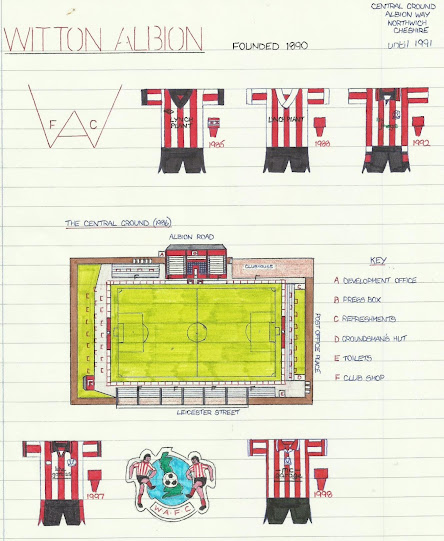Witton Albion FC is a non-league football club, founded in 1887, in the Cheshire town of Northwich by chemical workers. The team started out playing in the Northwich & District League, Crewe & District League, and the Cheshire League before joining The Combination in 1901-02.
Albion
advanced to the Manchester League and then Division Two of the Lancashire
Combination for the 1912-13 season, winning promotion as champions the
following campaign. The club became a founder member of the Cheshire County
League in 1919-20.
.jpg) |
| Wincham Park |
Local derbies at the time against Northwich Victoria saw heated battles in front of packed crowds, with Witton going on to win the league crown in 1948-49 and 1949-50, before finishing as runners-up in 1950-51. These were halcyon days at the Central Ground, which was located, as the name suggests, in the centre of town.
A third
Cheshire County League title followed in 1953-54. This was the same season as
the team exited the FA Cup in the second round against Grimsby Town, with
Witton also reaching the same stage a couple of seasons earlier, where
Workington ended their run.
 |
| Central Ground. Photo: Andy Dakin. |
The first round of the competition was reached in 1957-58, and then again in 1966-67, with Tranmere Rovers and Bradford Park Avenue being the victorious teams. The formation of the Northern Premier League in 1968-69 saw Witton overlooked, with Northwich Victoria's persuading other clubs not to admit their town rivals being thought to be the deciding factor.
This was at
a time when former Manchester City star, Ken Barnes, managed the side, before another
league runners-up place was accrued in 1978-79, leading to admittance into the
Northern Premier League, finishing as runners-up in their first season.
 |
| My drawing of the Central Ground, along with former club crests and team kits. Click on the image to enlarge it. |
The club sold their ground to Sainsbury and relocated to a new stadium called Wincham Park, which was opened in 1989. The NPL title was won in 1990-91, as well as the side reaching the semi-finals of the FA Trophy, where Kidderminster Harriers ended the dreams of a Wembley final.
Promotion to the Football Conference saw Albion join their rivals, Northwich Victoria. Albion reached the final of the 1991-92 FA Trophy but lost 3-1 to Colchester United at Wembley. 1992-93 saw Witton reach the semi-final of the competition once again, this time ending in aggregate defeat to Runcorn.
 |
| Central Ground. Photo: Andy Dakin. |
Meanwhile, the standard of league football proved to be too severe, as cash from the ground sale ran out, seeing the side relegated in 1993-94. The 1996-97 season saw a further demotion down to Division One of the Northern Premier League. A third-place finish was managed in 1999-00.
Promotion
back to the Premier Division was won in 2003-04, where they finished as
runners-up in 2006-07, a performance repeated twelve months later. Manager Jim
Vince, who had done a sterling job, resigned to be replaced by Nigel Deeley. Gary
Finley was soon appointed in his place. The team was relegated at the end of
the 2008-09 campaign.
 |
| Central Ground. Photo: Andy Dakin. |
The club was transferred to Division One North in 2010-11, winning promotion the following season via the playoffs with wins against Farsley and Curzon Ashton. The playoffs were reached again in 2012-13, with FC United of Manchester winning the semi-final tie.
.png) |
| Wincham Park |
Anthony Sheehan replaced Pritchard, who had spent nineteen years at the club, in August 2014, with Tony Sullivan coming in as manager just five games later. The team was relegated at the end of the season, with Scott Dundas coming in as manager. Two months into the new campaign, he was replaced by Carl MaCauley.
The club upset some of their loyal supporters, allowing Northwich Victoria to share Wincham Park for the 2015-16 season. 2016-17 saw Witton promoted via the playoffs following victories against AFC Rushden & Diamonds and Spalding United. Vics returned as tenants in the summer of 2018.
.png) |
| Wincham Park |
The 2021-22 season saw the team relegated to Division One West of the NPL, with Jon Macken coming in as the new manager. After a couple of seasons just missing out on a playoff position, Ben Harrison was appointed as manager in August 2024. Vics had departed after a dispute several months earlier.
Witton Albion FC will play in the Northern Premier League Division One West in the 2025-26 season.
My visit
Saturday 1st November 1986
My visit to
the Central Ground came about as I was in the car with my mate Gary Griffiths
on the way to Chester v Walsall. We had already been to Edgeley Park,
Stockport, which was locked with no access, and then Northwich’s Drill Field.
 |
| Central Ground. Photo: Andy Dakin. |
It was a short distance to Albion’s home, which was another excellent venue, with a main stand and covered terracing opposite. There were plenty of standing options for spectators, along with crush barriers.
It didn’t
cross our minds that both town centre grounds would no longer exist within a
decade or so, as both clubs built new stadiums, one rather more successfully
than the other.


.png)







.png)






.png)
.png)
.png)
